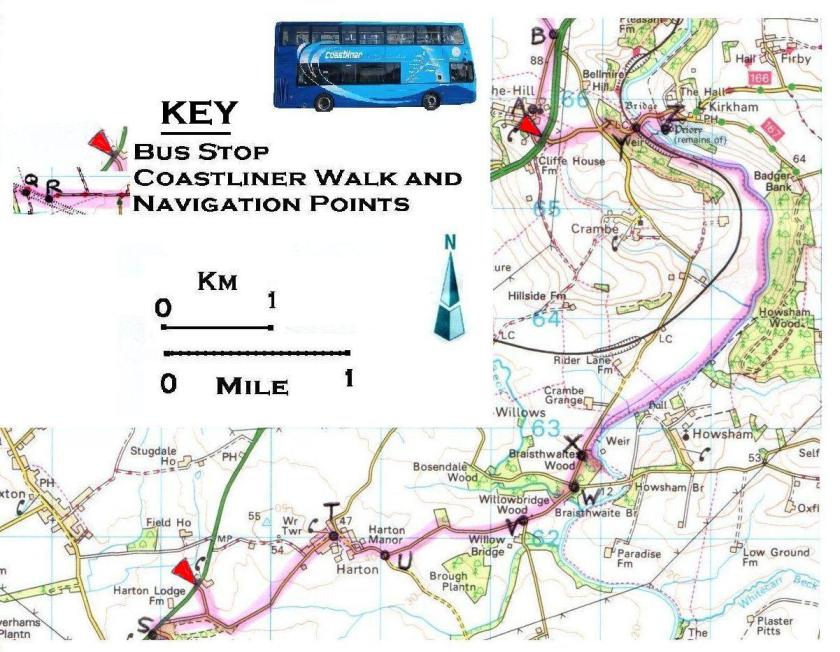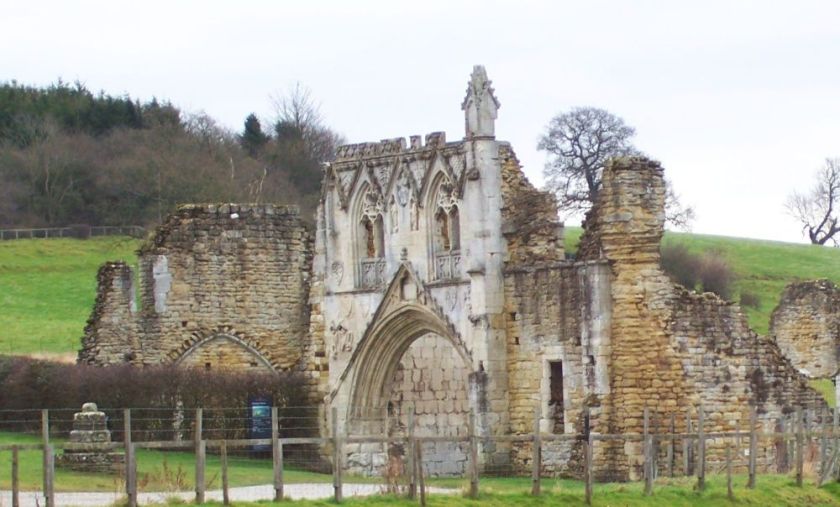Maps: OS Landranger 100; Explorer 300
Start: A64 at Gulf Oil garage (693616)
Finish: A64 at Onhams Lane (724656)
Distance: 6.9 miles (incl out-and-back to Kirkham Priory)
Going: Easy but one hill at the end
Natural England NCA: 28 (Vale of York) and 29 (Howardian Hills)
Special interest: Howardian Hills AONB, Kirkham Priory

1:50,000 OS © Crown copyright 2017 CS-05488-NOY1H7
Stay left on the road at (U) and again at (V). After going over Braisthwaites Beck you come quickly to the T-junction at (W). Here go left, then almost immediately right in the direction of Crambe.* Take the signed footpath (X) through Braisthwaites Wood to emerge at the side of the River Derwent. The fingerpost reminds us that we are now in the Howardian Hills AONB.

On reaching Kirkham Bridge (Y), you have a dilemma to ponder. The full ‘Coastliner Way’ walk includes crossing over Kirkham Bridge in order to say that you have, at the very least, actually touched the outside wall of Kirkham Priory (Z), one of Ryedale’s historic treasures. 
So, having completed the ceremony, and feeling terribly smug, all you have to do now is to climb the steep hill back up to the A64 and the Coastliner bus.
* For an alternative woodland walk, rather than a riverside stroll, consider turning right to Howsham and then using the track through Howsham Wood to Badger Bank, and then the road down to Kirkham Priory. The extra mileage is negligible although the ‘official’ Coastliner walk mileage remains that for the riverside route.
Special Interest
The Howardian Hills (NCA 29) is a clearly defined belt of irregular, rounded ridges of Jurassic Age rocks with intervening sheltered valleys. In a relatively small area, there is a diverse landscape of woodlands, historic buildings, designed parkland and villages, and rolling arable land on ridges and open plateaux. The Castle Howard Estate is a delightful amalgamation of natural beauty and human creativity. Three-quarters of the NCA lies in the Howardian Hills Area of Outstanding Natural Beauty (AONB).
Howsham Mill dates back to c.1755 and is attributed to John Carr of York. It was built in the Gothic Revival style both as a working grist mill and as an ‘eyecatcher’ or folly within the formal parkland of nearby Howsham Hall. The mill was powered by a waterwheel connected to millstones that ground the cereal grains into flour. Milling of flour ceased in 1947 and the building had fallen into decay by the 1960s.
Then in 2004 local residents formed the Renewable Heritage Trust with the intention of preserving and restoring the mill. Fund raising, volunteer labour and grant funding, totalling £450,000, enabled the first phase of the restoration to be completed in 2007.
Generating green energy has been a key concept in the restoration plan. This first stage of the project involved installing a new waterwheel and Archimedean screw as well as rebuilding the walls and roof of the granary to the north of the main building, so allowing the installation of a kitchen and toilets as well as housing the control equipment for the hydro generation.
The second phase of the project, which requires an additional £500,000, will connect the wheel and Archimedean screw to the national grid thus allowing the electricity generated to be sold. In addition the main building will be restored for use as an environmental study/community centre and an eco-camping barn. The finished building will house a permanent exhibition on the history of the mill and an extensive library on climate change and renewable energy.
In 2006 Howsham Mill was featured on the BBC television programme Restoration Village presented by Griff Rhys Jones. It won the North regional heat and was featured in the live National Final. Although Howsham Mill did not win, a £50,000 Project Planning grant was won by reaching the final (see howshammill.org.uk)
Kirkham Priory
Kirkham Priory was established around 1122 by Walter l’Espec, a nobleman of Helmsley, who later founded Rievaulx Abbey. He set up a house for Augustinian canons who lived a monastic life but who also worked in the nearby parishes. Today (and presumably when it was first built) Kirkham Priory appears to occupy an idyllic peaceful location on the banks of the River Derwent.
Yet during the Second World War the Priory’s tranquillity was shattered as troops put ‘wading’ vehicles destined for the Normandy beaches through their paces. With his country in the middle of building-up the greatest invading force the world has ever seen, Prime Minister Winston Churchill made a secret visit to Kirkham Priory to inspect preparations.
English Heritage, which takes care of the now ruined Christian site, has unveiled a plaque to commemorate Kirkham’s part in the preparation for the D-Day landings. One of seven storyboards illustrating the priory’s history, the plaque shows a photograph of Winston Churchill taken during his clandestine visit to inspect the troops. The then prime minister was joined by King George VI in a visit that was first brought to English Heritage’s attention by a local elderly resident. The visit to Kirkham by Churchill and the King shows that this was a key training area.
The rare photograph came to light after ‘Country Life’ magazine published an article referring to the priory’s war-time service. A reader came forward with the image, showing Churchill talking to his grandfather, who had served in the army. The British 11th armoured division was amongst the units moved to Kirkham to give drivers experience of manoeuvring and to test various waterproofing compounds. Vehicles ranged from tanks to jeeps. During the build-up to D-Day the A64 seemed like a massive car park for all kinds of military hardware. Troops also gained some useful experience by tackling Kirkham’s ancient walls using clambering nets. This was fitting practice for the rubble-strewn towns they were to encounter in northern France.
Other new storyboards focus on the site’s medieval heyday when the often poverty stricken monks had to juggle their finances and even got rebukes from the Archbishop of York for lapses in discipline. ‘Kirkham is a real gem and predates both Rievaulx and Fountains,’ says the Priory’s custodian Linda Teal, ‘but it’s a very different kind of monastery’. (Based on article by David Prudames Culture 24, May 2004)
